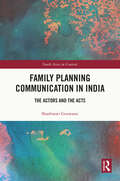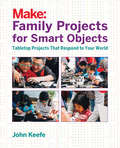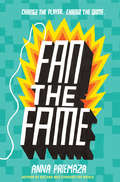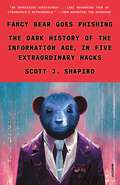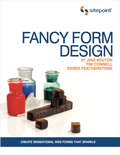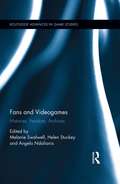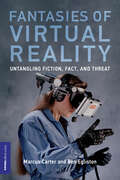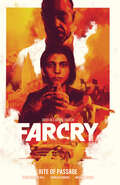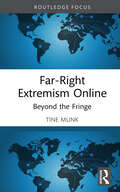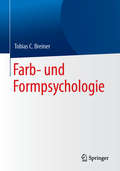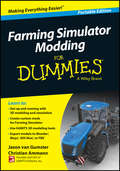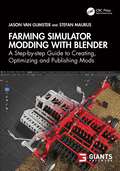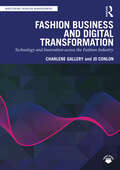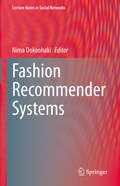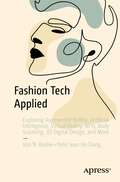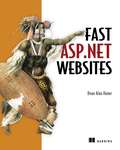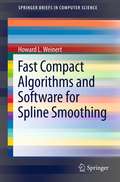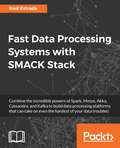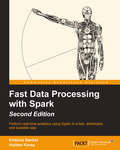- Table View
- List View
Family Planning Communication in India: The Actors and the Acts (South Asia in Context)
by Shashwati GoswamiThis book is the first systematic study on the historiography of the family planning communication process in India. It traces the history of the development of a highly technical health communication process. It discusses how the discourse on India’s population problem was at the heart of the development dialogue which was being promoted by the British colonial administration. The book examines the role of the censuses and the Five-Year plans in the development of the discussion on the population ‘explosion’ in India. Also, it critically discusses the role of the Ford Foundation’s leadership in institutionalising the communication process in India. The book essentially argues that population control communication enabled the ideas of a homogenised nation, an 'ideal' Indian woman and an ‘ideal’ Indian family. This, in turn, led to the obliteration of cultural, ethnic, geographical and economic specificities of India as a country. The volume will be of great interest to scholars and researchers of public policy, media and communication studies, Indian politics, modern Indian history and South Asian Studies.
Family Projects for Smart Objects: Tabletop Projects That Respond to Your World
by John Keefe"The Internet of Things" is the new buzzphrase, but what is it? A toaster that texts? The fitness band on your wrist? The camera in an infant's room? Sure, it's all of those things. But it's also your phone: an ultra-sophisticated sensor and communications system in your pocket or purse--capable of tracking your steps, capturing an image, or calling an Uber. And it is actually not hard or expensive to make a sensing, communicating object yourself. Doing so can be rewarding, fun, and even useful. This book teaches the basics of building sensors and communicating objects through a series of practical, demonstrative, and fun activities.
Fan the Fame
by Anna PriemazaSometimes before you can build something up, you have to burn it down. <P><P>Fans of Rainbow Rowell’s Fangirl and Jennifer Mathieu’s Moxie will fall in love with this fiercely crafted YA novel about followers, fame, and fighting for what’s right. <P><P>Lainey wouldn’t mind lugging a camera around a video game convention for her mega-famous brother, aka YouTube streamer Codemeister, except for one big problem. He’s funny and charming online, but behind closed doors, Cody is a sexist jerk. <P><P>SamTheBrave came to this year’s con with one mission: meeting Codemeister—because getting his idol’s attention could be the big break Sam needs. <P><P>ShadowWillow is already a successful streamer. But when her fans start shipping her with Code, Shadow concocts a plan to turn the rumors to her advantage. <P><P>The three teens’ paths collide when Lainey records one of Cody’s hateful rants on video and decides to spill the truth to her brother’s fans—even if that means putting Sam and Shadow in the crosshairs. <P><P>Told through three relatable voices, this contemporary YA novel from the author of the widely praised Kat and Meg Conquer the World skillfully balances feminism, accountability, and doing the right thing—even when it hurts.
Fancy Bear Goes Phishing: The Dark History of the Information Age, in Five Extraordinary Hacks
by Scott J. Shapiro“Unsettling, absolutely riveting, and—for better or worse—necessary reading.” —Brian Christian, author of Algorithms to Live By and The Alignment ProblemAn entertaining account of the philosophy and technology of hacking—and why we all need to understand it.It’s a signal paradox of our times that we live in an information society but do not know how it works. And without understanding how our information is stored, used, and protected, we are vulnerable to having it exploited. In Fancy Bear Goes Phishing, Scott J. Shapiro draws on his popular Yale University class about hacking to expose the secrets of the digital age. With lucidity and wit, he establishes that cybercrime has less to do with defective programming than with the faulty wiring of our psyches and society. And because hacking is a human-interest story, he tells the fascinating tales of perpetrators, including Robert Morris Jr., the graduate student who accidentally crashed the internet in the 1980s, and the Bulgarian “Dark Avenger,” who invented the first mutating computer-virus engine. We also meet a sixteen-year-old from South Boston who took control of Paris Hilton’s cell phone, the Russian intelligence officers who sought to take control of a US election, and others.In telling their stories, Shapiro exposes the hackers’ tool kits and gives fresh answers to vital questions: Why is the internet so vulnerable? What can we do in response? Combining the philosophical adventure of Gödel, Escher, Bach with dramatic true-crime narrative, the result is a lively and original account of the future of hacking, espionage, and war, and of how to live in an era of cybercrime.Includes black-and-white images
Fancy Form Design: Create Sensational Web Forms That Sparkle (Sitepoint Ser.)
by Jina Bolton Derek Featherstone Tim ConnellForms' - is there any other word that strikes as much fear into the hearts of web designers? Not any more ...Fancy Form Design is a practical hands-on, full color book that follows the process of creating visually stunning yet usable web forms, from start to end. The book covers all design elements from planning the form's purpose and interface through to mastering markup, applying style with CSS, and adding interactivity and visual effects with JavaScript. By the end of the you'll will have the code, and wisdom, they need to build fancy forms of their own.
Fans and Videogames: Histories, Fandom, Archives (Routledge Advances in Game Studies)
by Melanie Swalwell Angela Ndalianis Helen StuckeyThis anthology addresses videogames long history of fandom, and fans’ important role in game history and preservation. In order to better understand and theorize video games and game playing, it is necessary to study the activities of gamers themselves. Gamers are active creators in generating meaning; they are creators of media texts they share with other fans (mods, walkthroughs, machinima, etc); and they have played a central role in curating and preserving games through activities such as their collective work on: emulation, creating online archives and the forensic archaeology of code. This volume brings together essays that explore game fandom from diverse perspectives that examine the complex processes at work in the phenomenon of game fandom and its practices. Contributors aim to historicize game fandom, recognize fan contributions to game history, and critically assess the role of fans in ensuring that game culture endures through the development of archives.
Fantasies of Virtual Reality: Untangling Fiction, Fact, and Threat (Strong Ideas)
by Marcus Carter Ben EglistonThe fantasies that underpin common perceptions of Virtual Reality—and what we need to know about VR&’s potential risks as well as its opportunities.Virtual reality is the next new frontier for Silicon Valley. Mark Zuckerberg, who has overseen Meta&’s investment of billions into VR, pitches it as the next dominant computing paradigm. More than just a gaming technology, VR is top of mind for academics, tech reportage, and industry evangelists who all see the potential for VR to revolutionize fields such as education and health, as well as the way we work and communicate. But will VR achieve all this? In Fantasies of Virtual Reality, Marcus Carter and Ben Egliston strip bare the tech industry&’s vision of a future dominated by immersive VR experiences, challenging the utopian promises of this technology&’s potential.Carter and Egliston offer a critical account of VR in a variety of contexts, from gaming to human resources to policing and the military. They argue that while VR does hold significant potential, the overhyped expectations surrounding it, from achieving true empathetic understanding to transforming traditional education and office work, are often overstated and fraught with issues of privacy, control, and exclusion. What&’s more, there is nothing truly virtual about virtual reality: VR is deeply entrenched in the material world, driven by tangible technological, economic, and social logics.An accessible introduction to this emerging technology, Fantasies of Virtual Reality is essential reading for anyone interested in what VR can really do—and what is just plain fantasy.
Far Cry: Rite of Passage
by Bryan Edward HillIn this gritty tale of the intricate road in the ascension to power, Far Cry fans will be able to revisit the iconic villains Vaas Montenegro, Pagan Min, and Joseph Seed from the perspective of Far Cry 6 leader, Antón Castillo. Young Diego Castillo has just turned thirteen, but this birthday is more than a celebration—it&’s a rite of passage. His father takes him on a journey, teaching him important lessons in leadership and recounts cautionary tales he has heard about the undoing of three legendary men: Vaas Montenegro, a pirate, Pagan Min, a dictator, and Joseph Seed, a preacher. When he comprehends these lessons, will Diego be able to accept his destiny?A story about the challenge of upholding family legacy, written by Bryan Edward Hill (American Carnage, Killmonger, Fallen Angels), art by Geraldo Borges (Avengers, Star Wars: TIE Fighter), and colors by Michael Atiyeh (Assassin&’s Creed Valhalla: Song of Glory, The Division).Collects Far Cry: Rite of Passage #1-#3.
Far-Right Extremism Online: Beyond the Fringe (Routledge Studies in Digital Extremism)
by Tine MunkBy imparting crucial insights into the digital evolution of far-right extremism and its challenges, this book explores how far-right extremism has transformed, utilising digital spaces for communication and employing coded language to evade detection.Far-right extremism has spread extensively across online platforms. Flourishing within echo chambers, these groups propagate different types of online and offline actions and advance their hateful ideologies to a wide-ranging audience. This book highlights the issues surrounding far-right extremism, which distinguishing it from terrorism and examining its contemporary digital manifestations. Importantly, it sheds light on how far-right groups utilise online platforms for communication, radicalisation, and on-ground actions, relying on alternative truths, misinformation, conspiracy theories, fashion, and memes to connect with like-minded individuals. The book also addresses content moderation challenges and the impact of rising populism in today’s political climate, which fuels societal divisions and uncertainty.Far-Right Extremism Online is a valuable resource for academics, students, analysts, and professionals working in counter-extremism, cybersecurity, digital communication, and national security. It is also an indispensable guide for those concerned about far-right extremism in the digital age.
Farb- und Formpsychologie
by Tobias C. BreinerDieses Werk ist eine umfassende und praxisrelevante Darstellung zur Farb- und Formpsychologie. Mit einer klaren Sprache und über 100 farbigen Abbildungen wird Ihnen die komplexe Thematik auf eine wissenschaftliche und anregende Art veranschaulicht.Über eine allgemeine Einführung in die Grundlagen des visuellen Systems hinaus werden Sie ebenfalls spezielles Wissen zu Assoziationen, Wirkungen und Anwendungen bestimmter Farben und Formen erwerben. Speziellen Wert legt der Autor dabei auf deren Einsatz im Game Design. Es wird zudem erstmals eine neue Farbstudie präsentiert, die zeigt, dass die Assoziationen zu Farben sich in einem in sich logischen dreidimensionalen System anordnen lassen. Die daraus gezogenen überraschenden Erkenntnisse liefern mögliche Antworten auf fundamentale Fragen der Philosophie. Das Buch ist daher nicht nur ein Muss für Wahrnehmungspsychologen und Designer, sondern eine Bereicherung für alle an dieser Thematik Interessierten.
Farming Simulator Modding For Dummies
by Jason Van Gumster Christian AmmannLearn the basics of 3D modeling for the popular Farming Simulator gameDo you want to get started with creating your own vehicles, maps, landscapes, and tools that you can use in the game and share with the Farming Simulator community? Then this is the resource for you! With the help of Jason van Gumster, you'll get up and running on everything you need to master 3D modeling and simulation--and have fun while doing it! Inside, you'll find out how to create and edit maps, start using the material panel, customize your mods by adding texture, use the correct file-naming conventions, test your mod in single and multiplayer modes, get a grip on using Vehicle XML, and so much more.There's no denying that Farming Simulator players love modding--and now there's a trusted, friendly resource to help you take your modding skills to the next level and get even more out of your game. Written in plain English and packed with tons of step-by-step explanations, Farming Simulator Modding For Dummies is a great way to learn the ropes of 3D modeling with the tools available to you in the game. In no time, you'll be wowing your fellow gamesters--and yourself--with custom, kick-butt mods. So what are you waiting for?Includes an easy-to-follow introduction to using the GIANTS 3D modeling toolsExplains how to export models to Blender, Maya, 3DS Max, or FBXProvides tips for using the correct image format for texturesDetails how to use Photoshop and Audacity to create custom mods for Farming SimulatorWhether you're one of the legions of rabid fans of the popular Farming Simulator game or just someone who wants to learn the basics of 3D modeling and animation, you'll find everything you need in this handy guide.
Farming Simulator Modding with Blender: A Step-by-step Guide to Creating, Optimizing and Publishing Mods
by Jason van Gumster Stefan MaurusThis is a comprehensive guide to creating and customizing mods for the popular video game Farming Simulator within Blender. This book covers all aspects needed to create your own vehicle mods from start to finish.The book begins with a basic introduction in Blender before showing you how to prepare your hierarchy and set up pivots. You’ll then learn to create physics components and how to set up your ModDesc and Vehicle XML files. The book then covers all you need to know about implementing vehicle functions before applying LOD meshes ahead of testing and finally publishing your mod on the official GIANTS ModHub.This book will appeal to all Farming Simulator modders, as well as those looking to learn game development concepts within Blender.
Farmville 2 Country Escape Guida di Gioco non Ufficiale
by Valeria Ciccotti Hiddenstuff EntertainmentCon la mia guida di gioco non ufficiale di Farmville 2 imparerete esattamente tutto ciò che dovete sapere per diventare giocatori esperti, ottenere monete e contanti illimitati, e risorse illimitate! La guida tratta i seguenti argomenti: - Panoramica e informazioni di base. - Come giocare. - Risorse per le missioni. - Giocare con gli amici in modo efficace. - Come crescere le colture 2 volte più velocemente! - Creare la fattoria perfetta. - Come ottenere un sacco di denaro e banconote. - Come ottenere risorse illimitate. - Come avere gli animali premio. - Panoramica delle ricompense. - Segreti, suggerimenti e trucchi usati dai giocatori professionisti! - Istruzioni dettagliate passo dopo passo! - E MOLTO ALTRO! Acquistate adesso e non rimarrete più bloccati, senza monete e senza risorse! Diventate oggi giocatori di alto livello! Disclaimer: Questo prodotto non è associato, affiliato, sostenuto o sponsorizzato da Zynga Inc., e non sono stati effettuati test, recensioni o certificazioni. Questa guida va usata come riferimento. Questo prodotto non modifica il gioco in alcun modo. Questa è una guida scritta e non è un programma software. Keywords: Farmville 2,game,guide,cheats,hacks,app,download,game,free,play,online,zynga,quests,xp,exchange,recipes,tips,yogurt,unlimited,water
Farmville 2 Country Escape Guía de Juego
by Hiddenstuff Entertainment Valeria Lissbeth Aguirre S.Este libro en línea contiene descripciones y pasos de cómo jugar Farmville 2. Contiene conceptos básicos, desde cómo ganar monedas y cómo subir de nivel rápidamente, a cómo cuidar el ganado y los cultivos de una manera más sencilla. FarmVille 2 es gratuito de Facebook y para múltiples jugadores, además, se caracteriza por tener llamativos escenarios y personajes en 3D. El jugador puede crear una granja personalizada donde los cultivos puedan crecer y también se pueda alimentar a los animales; estos son recursos de varios cultivos que apoyan las actividades agrícolas.
Farmville 2 Guia de Jogo
by Hiddenstuff Entertainment Cínthia Regina GalvãoDescrição do livro: Com o meu Guia não oficial do Jogo Farmville 2 você vai aprender exatamente o que você precisa saber para se tornar um jogador experiente, obter dinheiro ilimitado e ouro, e recursos ilimitados! Meu guia abrange os seguintes: - Visão geral e informações Básicas - Como jogar o jogo. - Recursos de missões. - Jogando de forma eficaz com os amigos. - Como cultivar 2x mais rápido! - Criando a fazenda perfeita. - Como ganhar toneladas de ouro e dinheiro. - Como criar recursos ilimitados. - Como conseguir animais premiados. - Visão geral de sucessos. - Segredos, dicas e truques usados pelos jogadores profissionais! - Instruções detalhadas passo a passo! - E muito mais! Compre agora e nunca mais fique sem ouro ou recursos novamente! Torne-se um jogador de pontuação máxima hoje! Aviso Legal: Este produto não está associado, afiliado, endossado ou patrocinado pela Zynga Inc., nem foi revisto, testado ou certificado por Zynga Inc. Esse guia é para ser usado como uma referência. Isso não modifica ou altera o jogo de qualquer maneira. Esse é um guia escrito e não um programa de software.
Fashion Accessories Business
by Entrepreneur Magazine Eileen Figure SandlinA billion-dollar industry, fashion accessories offer a world of business possibilities for stylish entrepreneurs like you! From jewelry and handbags to scarves and hats, Entrepreneur covers the hottest accessories businesses within the flourishing fashion industry. Learn how to create and sell your own accessories, buy wholesale accessories for resale, or establish your own online or traditional store! Providing insider advice, tips, and tricks along the way, our expert fashionistas take you step by step and show you how to discover your specialty, establish your business, set up your home workshop and office, manage your finances, and much more! Choose from popular fashion accessory niches- handcrafted jewelry, handbags, belts, scarves, and hats Discover the right sales avenue for your products Outfit your home workshop and office with the right tools and supplies Partner with retailers and designers to boost brand recognition Efficiently manage inventory and supplies for easy order fulfillment Boost profits by expanding and cross-marketing your product line And moreTurn your passion for fashion into a successful business today!All Entrepreneur Step-By-Step Startup Guides Include: Essential industry-specific startup steps with worksheets, calculators, checklists and more Bestselling title,Start Your Own Business by Entrepreneur Media Inc., a guide to starting any business and surviving the first three years Downloadable, customizable business letters, sales letters, and other sample documents Entrepreneur's Small Business Legal Toolkit
Fashion Business and Digital Transformation: Technology and Innovation across the Fashion Industry (Mastering Fashion Management)
by Charlene Gallery Jo ConlonFashion Business and Digital Transformation provides a practical and holistic overview of the fashion industry and the key technologies impacting the fashion supply chain. It covers product design and development, production, sales and customer experiences in physical, online and virtual environments. The key technologies impacting the ecosystem are explored, including artificial intelligence, virtual reality, augmented reality, digital fashion design, NFTs, 3D textiles, and blockchain. Strategic concepts such as ‘retail-tainment’, ‘phygital’, gamification and e-commerce, are analysed, alongside the effect of these key strategies for both the retailer and the customer.Theoretical foundations are supported by extensive use of examples, interviews and case studies drawn from a wide range of global fashion disrupters and cutting-edge brands. Engaging activities, exercises, and technical step-by-step guides are incorporated throughout, which will both consolidate how technology is driving change in the industry, but also equip the reader with the key skills and digital literacy capabilities required by future practitioners. Online resources include chapter-by-chapter PowerPoint slides, a test bank and links to further resources.This examination of the digital transformation of the fashion industry will be essential reading for advanced undergraduate and postgraduate students of Fashion Management, Fashion Business and Fashion Technology.
Fashion Recommender Systems (Lecture Notes in Social Networks)
by Nima DokoohakiThis book includes the proceedings of the first workshop on Recommender Systems in Fashion 2019. It presents a state of the art view of the advancements within the field of recommendation systems with focused application to e-commerce, retail and fashion. The volume covers contributions from academic as well as industrial researchers active within this emerging new field.Recommender Systems are often used to solve different complex problems in this scenario, such as social fashion-based recommendations (outfits inspired by influencers), product recommendations, or size and fit recommendations. The impact of social networks and the influence that fashion influencers have on the choices people make for shopping is undeniable. For instance, many people use Instagram to learn about fashion trends from top influencers, which helps them to buy similar or even exact outfits from the tagged brands in the post. When traced, customers’ social behavior can be a very useful guide for online shopping websites, providing insights on the styles the customers are really interested in, and hence aiding the online shops in offering better recommendations and facilitating customers quest for outfits. Another well known difficulty with recommendation of similar items is the large quantities of clothing items which can be considered similar, but belong to different brands. Relying only on implicit customer behavioral data will not be sufficient in the coming future to distinguish between for recommendation that will lead to an item being purchased and kept, vs. a recommendation that might result in either the customer not following it, or eventually return the item. Finding the right size and fit for clothes is one of the major factors not only impacting customers purchase decision, but also their satisfaction from e-commerce fashion platforms. Moreover, fashion articles have important sizing variations. Finally, customer preferences towards perceived article size and fit for their body remain highly personal and subjective which influences the definition of the right size for each customer.The combination of the above factors leaves the customers alone to face a highly challenging problem of determining the right size and fit during their purchase journey, which in turn has resulted in having more than one third of apparel returns to be caused by not ordering the right article size. This challenge presents a huge opportunity for research in intelligent size and fit recommendation systems and machine learning solutions with direct impact on both customer satisfaction and business profitability.
Fashion Tech Applied: Exploring Augmented Reality, Artificial Intelligence, Virtual Reality, NFTs, Body Scanning, 3D Digital Design, and More
by Von N. Ruzive Peter Jeun Ho TsangProvide a more tactile experience for your customers, who won’t even need to physically visit stores while optimizing conventional production processes and eradicating the tenuous tasks that nobody really likes to do. Reevaluate all parts of the value chain. You’ll see the ways technology has been used by fashion brands so far within design, production, marketing, and retail. Then discover the market opportunity that technologies such as 3D printing, augmented reality, and more bring into the chain. Challenge the ways in which you implement basic functions in your own practices. Despite the dominance of brick & mortar stores, digital platforms have emerged to pave the way for more diverse retail experiences with the adoption of technology in the fashion industry.We’re talking about more than just online shopping. Tap into NFTs, online fitting rooms, and tech solutions for better customer acquisition and increased sales. Fashion tech is more than just clothing covered in LEDs. It is the adoption of value chain optimizations, customer experience enhancing tools, and advanced operations management into existing business models. When taken seriously by the industry, it will be the future of how we all sell and purchase our products and interact with them. With a particular focus on apparel, each section of this book will put a lens on the existing conventions practiced in the industry at all stages of the value chain and how the help of technology could completely transform fashion for a more cost efficient, sustainable and time efficient industry.Use augmented reality, virtual reality, NFTs, body scanning, 3D design, and more to completely revolutionize how you approach fashion. Both as a consumer and as an amazing designer! What You'll LearnBecome more creative in the way you hack any part of the fashion value chainSpark inspiration for implementations of new technologies in fashion for both customers and designersAdopt and stay forward-thinking by diving into where the industry currently is and where it is goingWho This Book Is ForDecision makers in fashion corporate companies and emerging fashion brands wondering how to innovate in the saturated fashion market, as well as, fashion students with an interest in building the future of fashion. No prior technology knowledge is needed.
Fashion and Lifestyle Photography: Secrets Of Perfect Fashion And Lifestyle Photography
by Dixie DixonSucceed in the commercial world and become a stand-out fashion & lifestyle photographer. "If you are interested in pursuing fashion and lifestyle photography, this book, from this rising young star of the field, is a must." - Joe McNally Only a few years ago, fashion photography used to be a stuffy world for a tiny elite. Now an explosion in social media and lifestyle advertising has created opportunities for a whole new breed of professional photographer. Fashion and Lifestyle Photography is based on the talks Dixie Dixon, a Nikon Brand Ambassador, has given to crowds at major international trade shows. Expanding on the subject in the book, she reveals how to succeed in this exciting marketplace, covering key topics such as:· Professional case studies· Behind the scenes· Lighting diagrams & gear· How to build your careerFrom finding your vision, to building your dream team, this book will provide you with the essential gear and know-how to capture the looks of the media world that leap off the page or screen."Dixie Dixon is a truly wonderful, vibrant young talent in the field of fashion and lifestyle photography. In this book, she takes you on a lively, complete tour of not only how to make compelling, beautiful photographs, but also how to grow a business, develop a signature look, make your own breaks, gather clients and keep them, use social media well, and assemble a great support team. And that's the short list. This book is full of gems about the seemingly small details that are essential to success." - Joe McNally
Fashion and Lifestyle Photography: Secrets Of Perfect Fashion And Lifestyle Photography
by Dixie DixonSucceed in the commercial world and become a stand-out fashion & lifestyle photographer. "If you are interested in pursuing fashion and lifestyle photography, this book, from this rising young star of the field, is a must." - Joe McNally Only a few years ago, fashion photography used to be a stuffy world for a tiny elite. Now an explosion in social media and lifestyle advertising has created opportunities for a whole new breed of professional photographer. Fashion and Lifestyle Photography is based on the talks Dixie Dixon, a Nikon Brand Ambassador, has given to crowds at major international trade shows. Expanding on the subject in the book, she reveals how to succeed in this exciting marketplace, covering key topics such as:· Professional case studies· Behind the scenes· Lighting diagrams & gear· How to build your careerFrom finding your vision, to building your dream team, this book will provide you with the essential gear and know-how to capture the looks of the media world that leap off the page or screen."Dixie Dixon is a truly wonderful, vibrant young talent in the field of fashion and lifestyle photography. In this book, she takes you on a lively, complete tour of not only how to make compelling, beautiful photographs, but also how to grow a business, develop a signature look, make your own breaks, gather clients and keep them, use social media well, and assemble a great support team. And that's the short list. This book is full of gems about the seemingly small details that are essential to success." - Joe McNally
Fast ASP.NET Websites
by Dean HumeSummaryFast ASP.NET Websites delivers just what it promises—practical, hands-on guidance to create faster, more efficient ASP.NET sites and applications. This book offers step-by-step .NET-specific examples showing you how to apply classic page optimization tips, ASP.NET-specific techniques, and ways to leverage new HTML5 features.About the TechnologyThere's a real cost to inefficient HTTP requests, overloaded data streams and bulky scripts. Server throughput is a precious commodity and seconds—even tiny fractions of a second—can seem like an eternity while a visitor waits for your site to load. As an ASP.NET developer, there are dozens of techniques you can apply immediately to make your sites and applications faster. You'll find them here.About this BookFast ASP.NET Websites delivers just what it promises—practical, hands-on guidance to create faster, more efficient ASP.NET sites and applications. This book offers step-by-step .NET-specific examples showing you how to apply classic page optimization tips, ASP.NET-specific techniques, and ways to leverage new HTML5 features.Readers should be familiar with basic HTML, CSS, and ASP.NET concepts.Purchase of the print book includes a free eBook in PDF, Kindle, and ePub formats from Manning Publications.What's InsideDrastically improved response timesTips for Webforms and ASP.NET MVC sitesOptimizing existing pages.NET-specific examplesAbout the AuthorDean Hume is a software developer and blogger based in the U.K. A passionate techie, he created the ASP.NET HTML5 toolkit and blogs regularly about web performance at www.deanhume.com.Table of ContentsPART 1 DEFINING PERFORMANCEHigh-speed websitesFirst steps toward a faster websitePART 2 GENERAL PERFORMANCE BEST PRACTICESCompressionCaching: The sell-by dateMinifying and bundling static filesHTML optimization tipsImage optimizationETagsContent Delivery NetworksPART 3 ASP.NET-SPECIFIC TECHNIQUESTweaking ASP.NET MVC performanceTweaking ASP.NET Web Forms performanceData caching
Fast Compact Algorithms and Software for Spline Smoothing
by Howard L. WeinertFast Compact Algorithms and Software for Spline Smoothing investigates algorithmic alternatives for computing cubic smoothing splines when the amount of smoothing is determined automatically by minimizing the generalized cross-validation score. These algorithms are based on Cholesky factorization, QR factorization, or the fast Fourier transform. All algorithms are implemented in MATLAB and are compared based on speed, memory use, and accuracy. An overall best algorithm is identified, which allows very large data sets to be processed quickly on a personal computer.
Fast Data Processing Systems with SMACK Stack
by Raul EstradaCombine the incredible powers of Spark, Mesos, Akka, Cassandra, and Kafka to build data processing platforms that can take on even the hardest of your data troubles! About This Book • This highly practical guide shows you how to use the best of the big data technologies to solve your response-critical problems • Learn the art of making cheap-yet-effective big data architecture without using complex Greek-letter architectures • Use this easy-to-follow guide to build fast data processing systems for your organization Who This Book Is For If you are a developer, data architect, or a data scientist looking for information on how to integrate the Big Data stack architecture and how to choose the correct technology in every layer, this book is what you are looking for. What You Will Learn • Design and implement a fast data Pipeline architecture • Think and solve programming challenges in a functional way with Scala • Learn to use Akka, the actors model implementation for the JVM • Make on memory processing and data analysis with Spark to solve modern business demands • Build a powerful and effective cluster infrastructure with Mesos and Docker • Manage and consume unstructured and No-SQL data sources with Cassandra • Consume and produce messages in a massive way with Kafka In Detail SMACK is an open source full stack for big data architecture. It is a combination of Spark, Mesos, Akka, Cassandra, and Kafka. This stack is the newest technique developers have begun to use to tackle critical real-time analytics for big data. This highly practical guide will teach you how to integrate these technologies to create a highly efficient data analysis system for fast data processing. We'll start off with an introduction to SMACK and show you when to use it. First you'll get to grips with functional thinking and problem solving using Scala. Next you'll come to understand the Akka architecture. Then you'll get to know how to improve the data structure architecture and optimize resources using Apache Spark. Moving forward, you'll learn how to perform linear scalability in databases with Apache Cassandra. You'll grasp the high throughput distributed messaging systems using Apache Kafka. We'll show you how to build a cheap but effective cluster infrastructure with Apache Mesos. Finally, you will deep dive into the different aspect of SMACK using a few case studies. By the end of the book, you will be able to integrate all the components of the SMACK stack and use them together to achieve highly effective and fast data processing. Style and approach With the help of various industry examples, you will learn about the full stack of big data architecture, taking the important aspects in every technology. You will learn how to integrate the technologies to build effective systems rather than getting incomplete information on single technologies. You will learn how various open source technologies can be used to build cheap and fast data processing systems with the help of various industry examples
Fast Data Processing with Spark - Second Edition
by Holden Karau Krishna SankarFast Data Processing with Spark - Second Edition is for software developers who want to learn how to write distributed programs with Spark. It will help developers who have had problems that were too big to be dealt with on a single computer. No previous experience with distributed programming is necessary. This book assumes knowledge of either Java, Scala, or Python.
